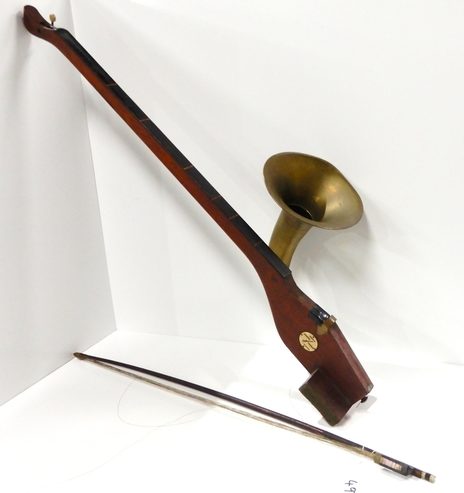Phonofiddle
Bowed Instruments
Europe
Between 1901 and present
Video
The Phonofiddle is a unique and intriguing musical instrument that has captured the attention of musicians and historians alike. Known for its distinctive sound and unconventional design, the Phonofiddle represents a fascinating chapter in the history of string instruments.
The Phonofiddle is a one-stringed musical instrument that belongs to the family of bowed string instruments. It is characterized by its use of a horn to amplify sound, which sets it apart from traditional fiddles or violins. The instrument typically consists of a long flat fingerboard with a single string stretched over it and a resonating body that incorporates a diaphragm similar to those found in early phonographs. This design allows the Phonofiddle to produce a unique sound that can range from thin and reedy to rich and resonant, depending on the player’s technique.
History of the Phonofiddle
The origins of the Phonofiddle can be traced back to late 19th-century England. The instrument was developed by Arthur Thomas Howson, a musical instrument maker who registered the ‘Phonofiddle’ trademark shortly after George Chirgwin popularized a similar one-stringed Japanese fiddle in London. Howson’s design was influenced by earlier instruments like the Stroh violin, which also used mechanical amplification through a horn. The Phonofiddle emerged during a time when novelty instruments were gaining popularity in music halls across Europe. Its unique sound and appearance made it an attractive option for entertainers looking to captivate audiences with something new and different. By the early 20th century, the Phonofiddle had become a staple in music halls, often featured in performances alongside other novelty instruments. Despite its initial popularity, the Phonofiddle’s appeal waned as musical tastes evolved. By the mid-20th century, it had largely fallen out of favor, becoming more of a collector’s item than a widely played instrument. Today, only a few examples remain in playable condition, making it a rare artifact of musical history.
How it Works
The mechanics of the Phonofiddle are both simple and ingenious. Unlike traditional string instruments that rely on their body for resonance, the Phonofiddle uses a diaphragm to produce sound. When the player draws a bow across the single string, vibrations are created. These vibrations are transmitted to the diaphragm, which amplifies them before projecting them through an attached horn. The horn serves as an acoustic amplifier, enhancing the volume and richness of the sound produced by the instrument. The player can manipulate tone and dynamics through bowing techniques and finger placement on the string. Although it may seem limited due to having only one string, skilled players can achieve a surprising range of sounds and effects.
Types and Features
The Phonofiddle is a unique and unconventional stringed instrument that combines elements of traditional violins with photographic technology. it stands out for its mechanical amplification system. Instead of relying on a wooden resonating body like a traditional violin, the phonofiddle uses a metal horn to amplify the sound. This design was inspired by the phonograph’s horn, hence the instrument’s name.
The phonofiddle typically has a single string, although some versions have two, and it is played with a bow, much like a violin. The string’s vibrations are transmitted to a metal diaphragm through a small bridge. The diaphragm then vibrates, sending sound waves into the attached horn, which projects the amplified sound outward. This mechanical amplification eliminates the need for a resonating wooden body, giving the phonofiddle its distinctive appearance and sound. The sound of the phonofiddle is often described as nasal, metallic, and slightly tinny, making it well-suited for novelty performances and certain styles of folk music. Its portability and mechanical design made it an intriguing alternative to traditional stringed instruments during its time. Today, the phonofiddle is considered a curiosity and is highly sought after by collectors and enthusiasts of rare and unusual musical instruments.
Kind of Music Composed
The music produced by the Phonofiddle is primarily rooted in folk traditions and popular music hall performances from its heyday. Due to its novelty status, there is no extensive traditional repertoire specifically for this instrument; however, it has been utilized in various musical styles including:
Folk Music: Often played in informal settings or gatherings.
Novelty Songs: Frequently featured in music hall acts where humor and entertainment were key.
Experimental Music: Contemporary musicians have begun exploring its unique sound within modern compositions.
While its limited range (just over one octave) may restrict complex melodies, creative players have found ways to adapt traditional tunes or create new pieces that highlight its distinctive voice.
Significance
The significance of the Phonofiddle extends beyond its musical capabilities; it serves as an important cultural artifact that reflects changing musical trends over time. As an example of early 20th-century novelty instruments, it illustrates how musicians sought new ways to engage audiences during an era marked by rapid technological advancements. In recent years, there has been renewed interest in vintage instruments like the Phonofiddle among collectors and musicians alike. This resurgence is part of a broader movement to preserve traditional music-making practices and explore historical instruments within contemporary contexts. Additionally, the Phonofiddle’s unique sound has attracted the attention of experimental musicians looking for unconventional timbres. Its ability to produce unexpected tones makes it an intriguing choice for those interested in pushing boundaries within their compositions.
FAQ
What materials are used to make Phonofiddle instruments?
Phonofiddles are typically made of wood for the body and a metal horn for sound amplification. Strings are usually gut or steel, and the bridge and tuning pegs are often crafted from hardwood.
What kind of music is played on the Phonofiddle?
Phonofiddles are often used for folk and experimental music due to their unique tonal qualities. They can also complement traditional string instrument ensembles.
How does the Phonofiddle differ from traditional violins?
The Phonofiddle differs from traditional violins by using a metal horn to amplify sound acoustically. This design produces a more mechanical, resonant tone distinct from the violin’s warm timbre.
 Links
Links
References
Other Instrument
Categories


















